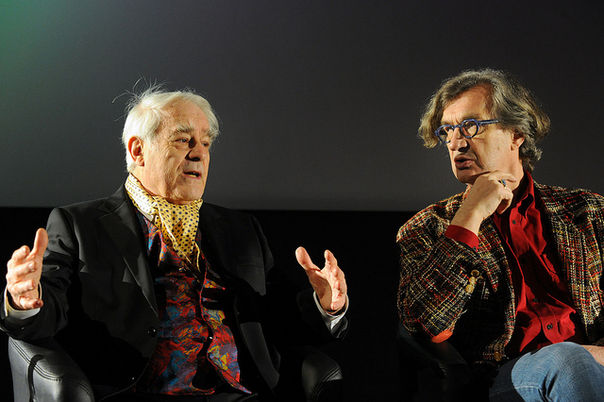The Uses of 3D Cinema
A panel discussion with Wim Wenders and his team about PINA and the future of 3D filmmaking.

Alain Derobe and Wim Wenders
Wim Wenders wanted to make a film about Pina Bausch almost from the time he first saw her dance productions on stage, over twenty years ago. "But," he added, speaking at Monday night’s Berlinale Talent Campus panel discussion on “New Horizons in 3D,” “what I admired most about Pina’s art was the reason not to make the film. There was something almost untranslatable, immediate, physical, about her work" that could not easily be brought to cinema. It wasn’t until the recent development of 3D technology that Wenders felt he could make his film with Bausch, who died shortly before it was to go into production. Wenders then decided to continue production of the film, with the dancers from Bausch’s company performing several of her most famous choreographies. At last night’s event, Wenders was joined by his producers Gian-Piero Ringel and Erwin Schmidt and his stereographer Alain Derobe in a discussion of the challenges they faced making PINA (which screens out of Competition at this year’s Berlinale), and to consider the future of 3D filmmaking.
Wenders believes that 3D offers profoundly new opportunities to filmmakers for the representation and preservation of life. "Between my cameras and Pina’s art, there was a wall. I didn’t have the tools to go there. But 3D opened the door into the realm of Pina’s dances, their immediacy and physicality." Rather than offering a conventional filmic preservation of Bausch’s stage productions, which rely so greatly upon their liveness and the interaction between the performers and the audience for their power, Wenders hopes that his film captures something of Bausch’s choreographies in their live physicality, using 3D technology to bring the performances closer to spectators.
Beyond the question of PINA’s success is the broader question of 3D's future as a viable form of filmmaking, at both the technological and the artistic level. Last night’s panellists spoke mostly about the technological difficulties of shooting and editing PINA – a 3D film that, unlike those we may be more familiar with, is entirely live-action and features many outdoor scenes, presenting new filmmaking challenges – but the pressing question of what 3D can contribute to filmmaking and to art was never entirely out of the picture.
Wenders' claims about 3D's capacity to bring "life" and the physical world to cinema in a profoundly new way may strike some as excessively utopian, but his conviction that 3D cinema can be used not to create fantasy worlds but to provide new insights into our own is certainly an appealing one. "It allows you as a filmmaker to be there in a different way, and to let your audience live with your protagonists in a different way." While the future of 3D cinema remains unclear, it is encouraging to find in Wenders a filmmaker concerned not merely with the awesome spectacle of the form but with its potential usefulness, its contribution to art's investigation of the world.


301 Moved Permanently